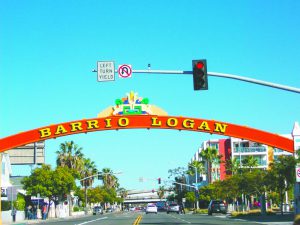By Estephania Baez
Logan Heights, better known as Barrio Logan, is located at the center of the City of San Diego, and is one of the oldest communities in the county, with a history that goes all the way back to the 1800s, when the area was used for Mexican revolution refugees. Over the years, this ethnic group became the predominant residents of the area, with 85 percent of its current population being Hispanic. Today, Barrio Logan is known for its historians, its art, its Chicano population, and of course Chicano Park, located under the Coronado Bridge and used as a meeting point by the Mexican-American community.
In spite of being located so close to the heart of one of the most metropolitan cities in the U.S., Barrio Logan was long known for its shootings, deaths, gangs, and a series of crimes that took place during the 80s and 90s; in fact, more than 60% of the crimes recorded during that time in San Diego County happened in Barrio Logan.
Barrio Logan Police Officer Víctor Alatorre shared that “Barrio Logan used to be nothing but gangs, graffiti on walls, fights, shootings… but now everything is more peaceful, many kids are now attending school, everything has been cleaned up, and people feel safer and are able to go out, not like before.”
A ha of abandoned homes and mysterious alleys still hold the secrets of hundreds of unresolved crimes committed back then, when Mexican cartels took over certain houses in order to commit their murders and even use them as safe houses in which to hide kidnap victims.
“You heard a lot of talk about mobs and the like, but everything is calmer now, business have come in and I think that’s better for all of us who live here”, shared Nora, a law student approached by La Prensa on her way to school.
Today, Barrio Logan has undergone significant transformation. The community tired of so much violence and made their voice heard, and little by little built a good place to live, far from crime and so much mischief. And it hasn’t only been the community; the San Diego County government has also turned its sights towards this area. In just the past two years, it has invested more than $6 million to build schools, libraries, pools, and other recreational spaces the border community can enjoy.
In contrast, of the 8,000 homeless people recorded in San Diego County, over 25 percent are from Barrio Logan; as a result, every November certain areas of Logan become shelter for those who have no place else to try and keep warm. Logan Avenue is turned into a winter shelter that can host up to 200 people, and will be open until next June. However, Councilmember David Alvarez – who came from this neighborhood – feels that more government support is still needed for this area.
Another project implemented in Barrio Logan was the creation of a new center, located on Imperial Avenue, to help the county’s workforce by providing workshops and training courses. It will also help connect the unemployed with local companies. In 2014, the City of San Diego also donated $30,000 from different foundations; the funds were obtained through a new non-profit called One San Diego. One of the largest donors was the Red Cross, which made a $15,000 donation.
After being considered the most dangerous place in San Diego County for many years, Barrio Logan has now become one of the places with the greatest potential for businesses.
